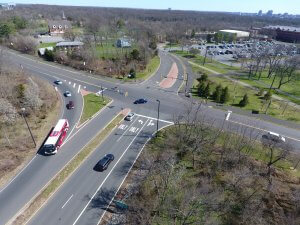
UTC partners developed an innovative AI tool that can help researchers better understand intersections and how to make them safer.
UTC partners at Rowan University conducted a study during the past year analyzing potential mobility and safety concerns of the transportation network surrounding the American Dream Mall in East Rutherford, New Jersey. The project was impacted by lessening traffic volume due to the COVID-19 pandemic, but the team was still able to collect valuable mobility data on the surrounding area while also developing an innovative AI tool to assess intersection safety.
According to the Federal Highway Administration (FHWA), more than 2.5 million intersection-related crashes happen annually across the country. In New Jersey, more than 34 percent of total motor vehicle crashes involve intersections.
In recent years, traffic congestion and motor vehicle crashes have become major concerns that are particularly difficult to manage in high-density urban areas. As a result, mitigating traffic congestion and improving user safety on roadways are top priorities of the United States Department of Transportation (USDOT).
The recent development and opening of the American Dream Mall Complex, an entertainment and retail center located at the Meadowlands Sports Complex in East Rutherford, New Jersey, presented new potential traffic and congestion problems in the region that affiliated researchers at the Rutgers Center for Advanced Infrastructure and Transportation (CAIT) set out to study.
With the building footprint exceeding 3 million square feet, The American Dream Mall is the second-largest retail and entertainment complex in the nation, and it is located within five miles of New York City. The complex officially opened in October 2019 and was expected to attract over 40 million annual visitors once fully operational.
“The mall was expected to draw large crowds, which in turn can add stress and demand to an already busy transportation system — potentially increasing congestion and safety issues,” said Dr. Mohammad Jalayer, lead PI on the project and an assistant professor of civil and environmental engineering at UTC partner school Rowan University. “So, we set out to conduct a feasibility study by evaluating the performance of four surrounding corridors on a monthly basis.”
First, the performance of four surrounding corridors was explored by incorporating travel time inflation (TI) as a performance measure. Then, researchers explored the impact of partial opening of the American Dream Complex on the surrounding corridors using probe vehicle data. Based on the results obtained from monthly based TI, Interstate 95, NJ Route 3, and NJ Route 120 experienced an increase in TI due to the partial opening of the American Dream Complex during both non-peak and peak hours.
Unfortunately, the COVID-19 pandemic lessened traffic volume in the area and the American Dream Mall was not fully opened and closed soon after the beginning of this project as a result.
Due to limited data collection opportunities during the pandemic, the research team alternatively purchased and used Streetlight data to assess the mobility impact of the partially opened Mall on the nearby corridors. In addition, the team also developed and validated an Artificial Intelligence (AI)-based video analytic tool and collected data at several intersections located outside of American Dream Mall complex in order to obtain sufficient vehicle and pedestrian trajectories.
The newly developed AI video analytic tool provides an excellent opportunity to assess intersection safety using Surrogate Safety Measures (SSMs) such as Post-encroachment Time (PET), Dr. Jalayer said. This is a proactive approach to enhance the safety of intersections, so there is no need to wait for crashes to happen.
He added that the results also demonstrated the tool could be used to assess the safety of both signalized and unsignalized intersections.
“This tool can help improve the safety of intersections and has the potential to save lives and reduce crash costs to society overall,” Dr. Jalayer said. “Our research also aligns with the strategic goals of the USDOT as reducing congestion and enhancing traffic safety on America’s transportation roads are USDOT top priorities, and we look forward to continuing to use innovative technology to keep our intersections safe moving forward.”

